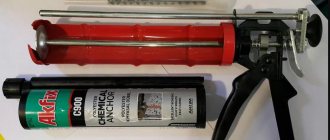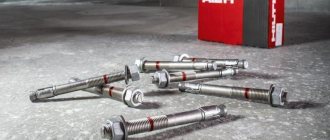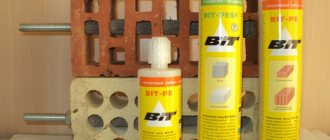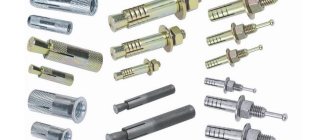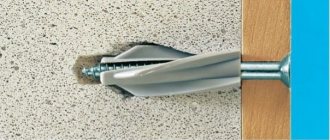If a mechanical anchor is a fastening familiar to even the most inexperienced craftsmen, then the situation with a chemical one is more complicated. What is it, how durable is the construction product, what are the areas of application of the adhesive composition, what types exist - we will try to get answers to these and other questions in this review.
Scope of application of chemical anchor
Chemical anchors for concrete are used when connecting critical structural elements at all stages of construction, building construction, laying subway lines, fastening mine arches in the mining industry and in everyday life during the construction of houses, cottages with porous concrete, fastening doors, windows, and furniture to walls.
- When constructing foundations of buildings and structures at high humidity and low temperatures,
- Construction of high-rise buildings, skyscrapers, exhibition centers, production workshops,
- Connecting bridge spans, arches, beams, trusses,
- Fastening metal parts to concrete bases,
- An auxiliary element for tying reinforcement under the foundation,
- When laying subway tunnels, strengthening mines in the mining industry,
- Installation and installation of high-voltage power lines, especially in areas of rivers, lakes, swamps, permafrost areas,
- Repair and construction of roads, highways, runways, construction of ports, shipyards, underground bunkers,
- Entertainment industry, installation of prefabricated foundations, industrial buildings, shopping centers, water parks, ski lifts,
Installation of equipment, machines, transformers, conveyors, loading equipment,
The use of chemical anchors is advisable in the construction of any facility, from the infrastructure of pipelines, stations and ending with the arrangement of plots, cottages, houses and living rooms.
Fastener design
There are two types of anchorage depending on the location and method of applying the adhesive:
- The himanker is attached using an injection glue gun, which is loaded with two capsules of resin and hardener. Using piston pressure, their contents are squeezed out of the containers and mixed into a homogeneous mass in the nozzle of the gun using a spiral. The adhesive composition is fed into a drilled hole with an anchor rod fixed in it. The solution fills the entire volume of voids around the fasteners, including voids in brick or foam block.
- The glass capsule contains the active component of glue and hardener, separated by a partition. The mounting hole is drilled along the diameter of the capsule. The container is inserted into the prepared recess and a pin is inserted using a drill or hammer, which breaks the wall of the capsule. The adhesive and hardener are mixed to firmly secure the stud into the wall. Glass shards additionally reinforce the fastening.
Important! The capsule anchor is not used for vertical fastening in ceilings. The glue may leak and the connection will not form.
A chemical anchor consists of several parts that form a connection:
- Adhesive based on phenol-formaldehyde, polyurethane or polystyrene resin,
- The hardener accelerates the drying process of the adhesive composition,
- Fillers increase the strength and reliability of the connection, usually quartz sand or cement is used,
- A metal rod in the form of a bolt, pin, nail or piece of reinforcement.
How to use?
Before installing an anchor that relates to chemistry, you need to carefully study the instructions for use. This allows you to take into account all the necessary nuances, for example, calculate the installation diagram and much more.
The first stage is preparing the hole. On the base, marks are made in the places where the fasteners will be installed. Then a hole is drilled with a drill a maximum of 2 millimeters wider than the diameter of the stud. The drill must be held perpendicular to the surface. The depth of the hole can be controlled using special stops or by placing a mark on the drill. To ensure that future fasteners are reliable, the hole must be cleared of dust and dirt. The procedure is carried out using a special brush and a hand-held or construction vacuum cleaner - it all depends on the volume of work being performed.
The second stage is the introduction of the adhesive mass. A nozzle is installed on the cartridge, and the entire structure is inserted into a special gun. First, squeeze out a small amount of the chemical composition, about 10 centimeters, to make sure that all components are mixed evenly - there is no need to use them. The mixer spout is placed in the hole, then the mixture flow is controlled by pressing the gun start button. The hole is filled to approximately 2/3 of its volume.
The third stage is the installation of the metal rod. To ensure that the adhesive mass is evenly distributed inside the hole, the fastener can be “pulled out” a little and then screwed in completely. While the adhesive is curing, you can control the position of the anchor. You can determine whether the hole has been filled with mass or not by its appearance - if the glue comes out, it means the installation is airtight.
The final step is to install and tighten the nut. After the solution has completely hardened, all materials and elements can be fixed. Use a torque wrench to tighten the nut. Manufacturers indicate in their recommendations what maximum force should be applied when tightening the nut. It is not recommended to use a traditional wrench, as there is a risk of exceeding the force and rendering the material unusable.
If there are breaks during installation, the mixer spout is not removed from the cartridge, but is replaced with a new one before continuing work.
Some builders prepare the solution themselves. To do this, mix epoxy resin, hardeners (UP-583), cement or gypsum mortar and a substance that imparts plasticity (DBP or DEG-1). The resulting mixture is thoroughly mixed. It is best to mix the solution in small quantities, then use immediately.
The following video describes the installation of chemical anchors.
Himanker for aerated concrete
The porosity of aerated concrete blocks used for the construction of building walls ranges from 40 to 85%. This material is not suitable for attaching heavy hanging structures, furniture elements, suspended ceilings, cabinets to it using nails, dowels or expansion anchors. It uses a chemical anchor for aerated concrete.
Types of fastening depending on the adhesive composition:
- In addition to strong, reliable fixation, epoxy-acrylic adhesive is fire-resistant, frost-resistant, and has a hardening time of 15 to 180 minutes.
- Polyester or polyester reagent is used at room temperature, curing time is from 25 minutes.
- Based on vinylester resin. The reagent is safe for metal, does not cause corrosion, is used in conditions of high humidity, hardening time is up to 24 hours.
- Epoxy adhesive is used when working with all types of concrete. Used for interior and exterior work, moisture-resistant, non-corrosive, used when using smooth fittings and studs without threads.
Liquid nail for hollow bricks
A chemical anchor for hollow bricks reliably fixes the stud in the hole, filling all nearby voids with adhesive. A strong connection is obtained due to the large area of adhesive, which seeps through the pores, cracks and voids in the base of the material.
For these purposes, injection formulations are used, which are loaded into an injection gun. Use the cartridges until they run out of substance. Tubes have a volume of up to 400 ml. Polyurethane, acrylic, phenol-formaldehyde and other types of glue are used as fillers.
Advantages and disadvantages
Chemical anchors continue to gain popularity. This is due to their unique properties. Experts highlight the following advantages of the material:
- no tensile stress is formed in the concrete during installation;
- the hole for installing the liquid anchor is completely sealed;
- easy to use, so even a person without experience can handle the installation;
- wide scope of application;
- high level of strength;
- the glue is highly resistant to atmospheric and chemical influences, as well as corrosion;
- There are types of anchors that can be used for wet surfaces;
- service life more than fifty years;
- Some manufacturers produce formulations that do not contain styrene (a toxin).
The disadvantages of using the material are the following:
- high cost;
- rapid spoilage when opening the package;
- short shelf life of sealed packaging (up to a year);
- long hardening.
Technology of use
Do-it-yourself installation of chemical anchors does not require special equipment or training. It is easy to do it yourself if you have a tool that every owner has.
Mark the intended location for fastening. Using a hammer drill with a diamond tip drill, drill holes that should be 2 mm larger than the diameter of the anchor pin or bolt.
Carefully remove dust from the middle.
- Insert an ampoule of glue into the hole, tighten the bolt or pin with an electric drill or hammer it in.
- If a cartridge is used, squeeze out the adhesive until the hole is completely filled, and insert the pin.
- Wait until the components specified in the attached instructions are completely dry and proceed with further installation.
Each type of anchorage is supplied with detailed instructions by the manufacturer, which explain in detail all stages of the work. The instructions must be strictly followed.
What does our company offer?
The UNIFORM-METAL online store has a wide range of various products for creating high-quality fastening connections. We offer over 15 groups of products to solve various specific problems of arrangement and further preparation for operation of structures.
Also with us you will find materials for any type of work, including turnkey construction and preparation of an old facility for reconstruction activities.
The chemical anchor and other elements of our range are characterized by guaranteed quality and confirmed technical characteristics. We cooperate exclusively with trusted manufacturers, and therefore provide you with high-quality products for construction, repair, and installation of any structures, both industrial and domestic.
We offer individual terms of cooperation with favorable pricing programs to regular and wholesale customers. We provide corporate customers with separate offers with a discount system.
